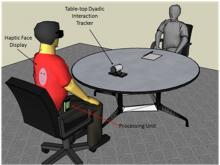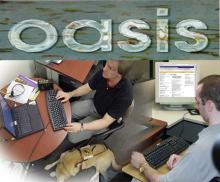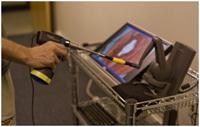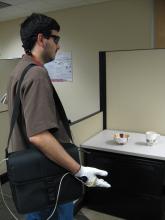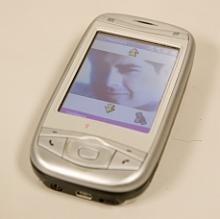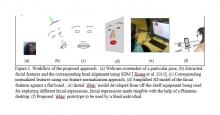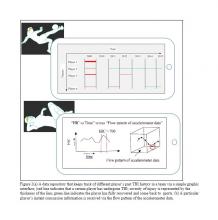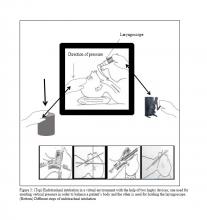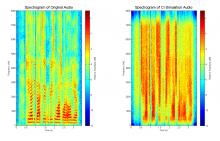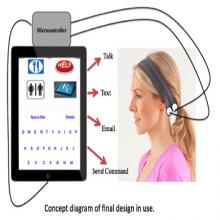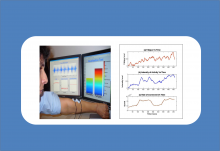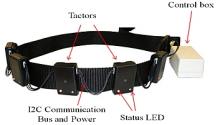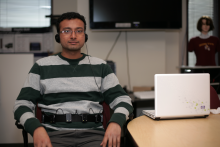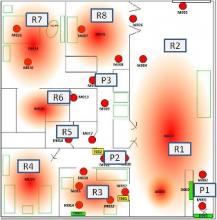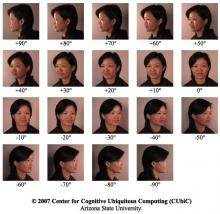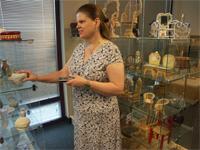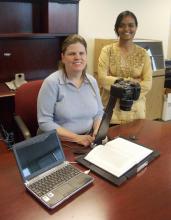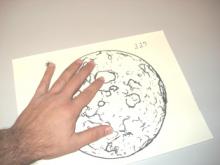Automated verification of human identity is indispensable in security and surveillance systems and also in applications involving assistive technology. Uni-modal systems relying on a single modality for authentication suffer from several limitations. Multi-modal systems…
The Dyadic Interaction Assistant, part of the larger Social Interaction Assistant research project, consists of a webcam on a pan-tilt mechanism used to track human faces, regardless of whether the person is directly facing the camera. Additionally, the video collected…
In CUbiC under the iCare project at Arizona State University, in partnership with Arizona's Rehabilitation Services Administration, we are developing a digital library system for delivering textbooks and other course materials to postsecondary education students, who are…
For an individual who is blind, the ability to reach for an object is a slow and often frustrating activity. The ability to locate an object within the grasp of the individual would be of great assistance. This would allow for the individual who is blind to reach for the…
Development and refinement of surgical skills are critical and time consuming components of the training curriculum of novice surgeons. Traditional methods for surgical training and evaluation are known to be long-drawn processes in which interns and junior residents…
Surgical training typically involves training by performing procedures on synthetic bone models. The bone models used in training are prone to significant wear and tear. This coupled with the lack of cheap yet high quality models affect the quality of the training itself…
Prosopagnosia is a condition where individuals with otherwise normal vision are able to see faces, but cannot recognize faces. A major study in Germany (Kennerknecht 2006) reported that a congenital (inherited) form of prosopagnosia occurred at a rate of 2.5% in a sample…
Humans have the uncanny ability to estimate how an object feels in terms of its shape, size, texture, material, etc., entirely from its visual image. From a biological standpoint, algorithms that estimate haptic features from images mimic the human ability to transfer…
Modern cellular phones are growing increasingly complex and have reached the point where even dialing a number and placing a call can be difficult, especially for those with a variety of visual or cognitive disabilities, as well as the elderly. Phones, such as GreatCall'…
People who are blind have the inherent tendency of exploring their interaction partner’s face to know them better and feel closer. This becomes a necessity when partners become engaged in a conversation and want to be aware of the different facial expressions. Current…
The goal of this project is to build a moble-based simple TBI repository system that consists of top down classification of players where leaf nodes represent individual players and the parent nodes represent the relationship (Club/ Team/ Sport) that binds the child…
Medical practitioners face difficulty in practicing endotracheal intubation in real world due to lack of frequent access to patients. Improper handling can result in severe injury like the breaking of patient’s teeth. Practicing on dummies does not reflect the real world…
People with auditory disabilities are at a disadvantage due to their inability to access the details of their surroundings conveyed through sound. Though a cochlear implant can empower a person to interact socially, it lacks an adequate resolution to provide the rich…
For paralyzed persons who still retain high-level mental function, patients with neurodegenerative diseases such as locked-in syndrome or Amyotrophic Lateral Sclerosis (ALS), or patients recovering from a stroke or just out of surgery, communication becomes an extremely…
The emergence of inexpensive and unobtrusive physiological sensors has widened the application of physiological sensing to newer and innovative areas including human-computer interface, proactive human health monitoring, emotion recognition, activity recognition and many…
Finger motion and hand posture of six professional clarinetists were recorded using a pair of CyberGloves®. Performance tasks included performing a slurred three-octave chromatic scale in sixteenth notes, at sixty quarter-note beats per minute, three times, with a…
Recently, much research in the area of haptic technologies has focused on the development of waist-worn haptic belts, also known as vibrotactile or vibration belts, as a substitution or augmentation modality for audio-visual information. Vibrotactile belts have been used…
To take notes in class, students with visual impairments must rapidly switch between writing their notes (a near-sight task) and viewing a board at the front of the classroom (a far-sight task). Current assistive technologies provide magnification for near-sight tasks,…
Traditional approaches to human activity recognition relying on vision as the primary sensory medium have met with little success. The emergence of the ubiquitous and pervasive paradigm of computing has ushered in new low bandwidth wearable, unobtrusive, inexpensive and…
Transit Tracker is a website and mobile application for tracking modes of public transportation in near real-time. A strong emphasis of the project is to provide a non-invasive assistive technology tool for visually impaired public transportation users, while extending…
In literature, such as novels, an elaborate account of a scene, in terms of the location, ambience, and presence of characters, is presented prior or during the conversation of those characters in the scene. In movies, similar information is portrayed, but through the…
Smart Homes are equipped with several sensors and one set of useful sensors are activation sensors that give out On/Off information as and when a resident passes by. The frequency with which these sensors may get fired depends on the activity of the smart home resident.…
FacePix is a face image database created at the Center for Cognitive Ubiquitous Computing (CUbiC) at Arizona State University, and made available free of charge to the worldwide research community. In the first version of the FacePix database, called FacePix(30), there…
The Tabletop Interaction Assistant, part of the larger Social Interaction Assistant research project, consists of a webcam on a pan-tilt mechanism used to track human faces, regardless of whether the person is directly facing the camera. Additionally, the video collected…
The goal of the project is to help people who are blind or visually impaired to shop independently. Present day shopping environments are centered around the needs of the consumer, and they aim to facilitate convenient access to different product lines varying from…
The inspiration for the iCare Reader was provided by focus groups of people who are blind, who asked CUbiC researchers for a reading machine that could be taken anywhere, and that was easier to use than the traditional flatbed scanning technology solutions that are…
The Remote Visual Explorer is designed to be an intuitive and natural extension of the human vision system. By integrating an eye-tracking monitor and a camera on a pant-tilt mechanism it allows an individual to explore a remote location. The user simply sits in front of…
CUbiC@ASU is engaged in an active collaboration with a high-volume cardiology practice catering to patients across Arizona - Advanced Cardiac Specialists - to design and develop computational tools and frameworks for cardiac decision support. While there are publicly…
While technologies such as screen-readers and refreshable Braille displays exist to allow individuals who are blind access to textual information, there is still a lack of devices that can automatically convey pictorial content to an individual who is blind. A rough…




